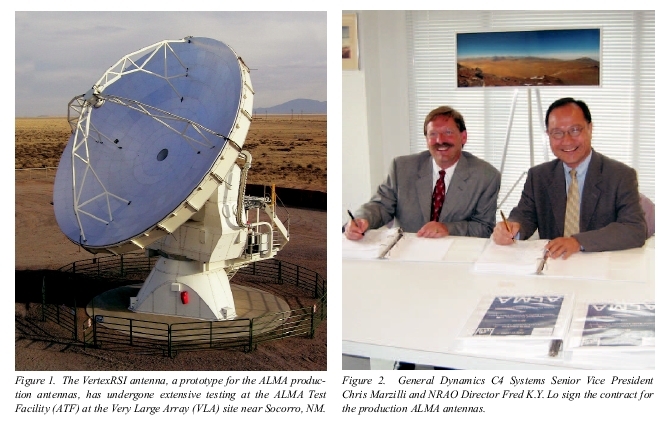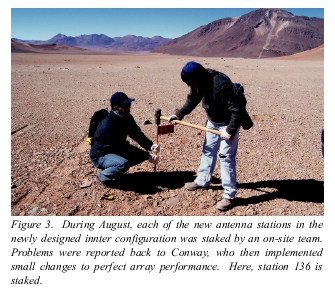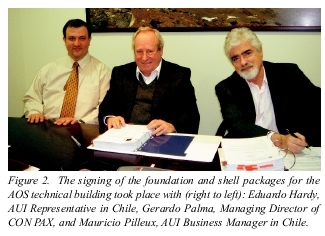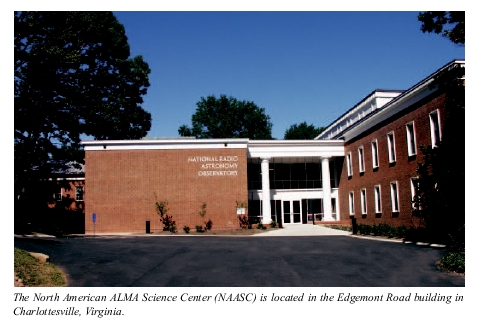ALMA NRAO News October 2005
ALMA News from the October 2005 Issue of the NRAO Newsletter
ATACAMA LARGE MILLIMETER ARRAY
Upcoming NAASC ALMA Workshop From z-Machines to ALMA: (Sub)millimeter Spectroscopy of GalaxiesOn January 13-14, 2006, the North American ALMA Science Center at NRAO will sponsor a workshop in Charlottesville, Virginia on (sub)millimeter spectroscopy of high-redshift galaxies. In the last decade, deep imaging from infrared through radio wavelengths has revealed important populations of distant, dusty galaxies with high rates of star formation and/or accretion. Multiple efforts are now underway to build dedicated, wide-bandwidth instruments (“z-Machines”) that can directly determine molecular emission-line redshifts for sources too obscured to be easily studied at short wavelengths. With ALMA now under construction, it is timely to convene a workshop whose goals are to:
Serving on the Scientific Organizing Committee are Andrew Baker (chair, NRAO/University of Maryland), Andrew Blain (Caltech), Neal Erickson (University of Massachusetts), Xiaohui Fan (University of Arizona), Jason Glenn (University of Colorado), Eduardo Hardy (NRAO), Andrew Harris (University of Maryland), Gordon Stacey (Cornell), Paul Vanden Bout (NRAO), and Min Yun (University of Massachusetts). John Hibbard is chairing the Local Organizing Committee. The first announcement, a list of confirmed speakers, and web forms for preregistration and abstract submission are available at http://www.cv.nrao.edu/naasc/zmachines/. Students are especially encouraged to attend. We look forward to seeing you there! A. Baker, J. Hibbard, and P. Vanden Bout |
ALMA Town MeetingALMA will hold a Town Meeting at the January meeting of the American Astronomical Society, to be held January 8-12, 2006 in Washington, D.C. The purpose of this Town Meeting is to inform the membership of the status of the ALMA Project. By the time of the AAS meeting in Washington, the production antenna contract will have been let, and construction in Chile will have advanced substantially. Further, the North American ALMA Science Center (NAASC) will have begun initial operations in preparation for ALMA Early Science. At this Town Meeting, the progress of ALMA construction and plans for the NAASC and Early Science will be presented, with ample time allocated for answering questions from the audience. The January AAS meeting will also feature special sessions for the Herschel Space Observatory and the Submillimeter Array (SMA). These should be of great interest to all potential ALMA users, too. Alwyn Wootten ALMA Antenna Contract Signed
The National Science Foundation (NSF) and Associated Universities, Incorporated (AUI), which operates the National Radio Astronomy Observatory for the National Science Foundation, are pleased to announce that on July 11, 2005 AUI signed a contract with Vertex Communications Corporation to purchase up to 32 antennas for the Atacama Large Millimeter Array (ALMA). NSF authorized AUI to negotiate and sign a contract to purchase North America’s share of the ALMA antennas following a long and careful procurement process which included extensive coordination with North America’s European partner, the European Southern Observatory (ESO), and with the Joint ALMA Office (JAO), which is overseeing construction of the array. |
The prototype antennas have been thoroughly tested to determine their worthiness for ALMA and to fine tune procedures for testing the production antennas, the first of which is expected to arrive in Chile in early 2007. As part of its contribution to ALMA, Japan has signed a contract for four 12m antennas, a component of the Atacama Compact Array. These antennas are also expected to arrive at the ALMA site in 2007. The prototype antennas, now at the ALMA Test Facility (ATF) at the VLA site, will undergo several changes as the year winds down.
|
The Japanese prototype will return to Japan for refurbishing and eventual shipment to Chile. The remaining two prototypes will be used as a testbed for ALMA equipment and procedures; they will be re-equipped as a one-baseline interferometer over the coming months. Meanwhile, the site in Chile will be prepared to receive the telescopes and the signals from them. The ALMA configuration has been redesigned by John Conway and Mark Holdaway to provide excellent imaging on fewer antenna stations than were previously employed in the design. Careful attention was paid to the imaging properties of intermediate arrays; the new design should provide excellent imaging characteristics for either a 50 or 64 antenna array. Alwyn Wootten |

|
AOS Technical Building Construction to Begin

|
The major ALMA facility at the 16,000 foot level on Chajnantor is the ALMA Array Operations Site (AOS) technical building, which houses the ALMA correlator, the Atacama Compact Array correlator, local oscillator elements and other electronics. From here the correlated signals are sent, along with other data, to the Operations Support Facility, several tens of kilometers distant at an elevation just below 10,000 feet, where they are archived and undergo first analysis. On August 2, the contracts for the foundation and shell packages for the AOS technical building were signed at the NRAO/AUI offices in Santiago with Chilean company CON PAX. Mobilization is underway and construction is scheduled to start on September 20, 2005. The foundations are scheduled to be completed on December 20, 2005, and the shell structure is scheduled to be finished on March 20, 2006. This work will mark the beginning of construction for ALMA on the high-elevation site. Alwyn Wootten |
North American ALMA Science Center
|
The North American ALMA Science Center (NAASC) is located in the Edgemont Road building in Charlottesville, VA. It is the regional contact point between the North American ALMA community and the ALMA project. 
An application was filed with the American Astronomical Society (AAS) for a Town Meeting at the Washington D.C.meeting of the Society, January 8-12, 2006. That application has been approved. The 2006 summer meeting of the AAS will be held in Calgary, Canada, with the first day a joint meeting with the Canadian Astronomical Society (CASCA). We are planning a Special Session on ALMA for that day, with colleagues in Canada taking the lead. |
The ALMA North American Science Advisory Committee (ANASAC) is composed of representatives of the wider North American astronomical community who provide scientific advice on the operation of the NAASC. The ANASAC met several times over the summer, in a telecon on April 29, 2005, at a face-to-face meeting at the Center for Astrophysics, Harvard University, on June 12, 2005, and in a telecon on August 26, 2005. The committee discussed the scientific impact of various ALMA design considerations, gave input into the antennae procurement process, and took the lead in scheduling the first North American ALMA Workshop – From z-Machines to ALMA: (Sub)Millimeter Spectroscopy of Galaxies. At the face-to-face meeting in Cambridge, the ANASAC elected Richard (Dick) Crutcher (University of Illinois) as their new Chair. Dick takes over these duties from Min Yun (University of Massachusetts), who deserves our thanks for his hard work as the original ANASAC Chair. The next ANASAC telecon is scheduled for October 28, 2005. A listing of the ANASAC membership and scheduled meetings is given at Paul Vanden Bout |




Connect with NRAO